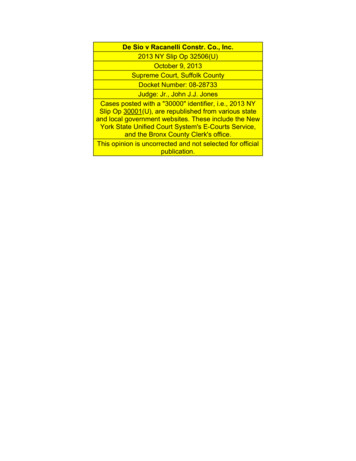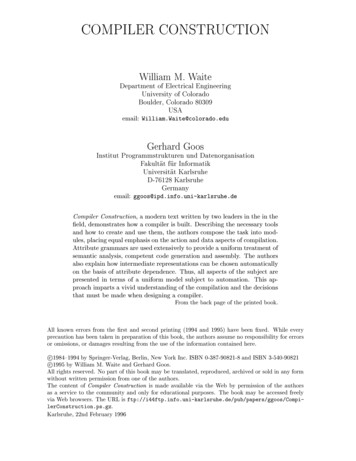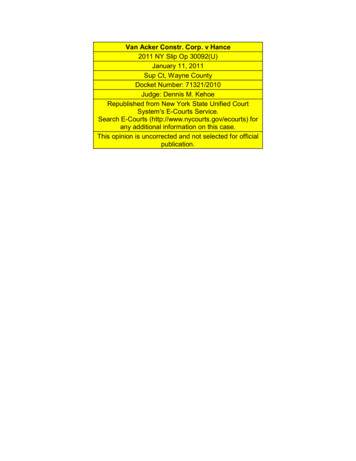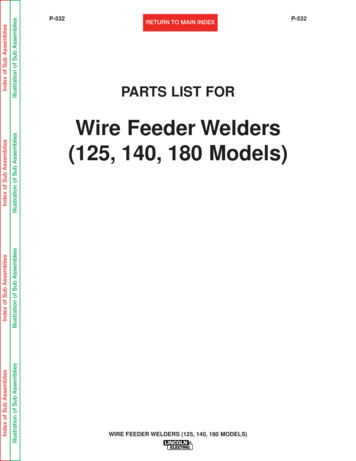
Transcription
De Sio v Racanelli Constr. Co., Inc.2013 NY Slip Op 32506(U)October 9, 2013Supreme Court, Suffolk CountyDocket Number: 08-28733Judge: Jr., John J.J. JonesCases posted with a "30000" identifier, i.e., 2013 NYSlip Op 30001(U), are republished from various stateand local government websites. These include the NewYork State Unified Court System's E-Courts Service,and the Bronx County Clerk's office.This opinion is uncorrected and not selected for officialpublication.
[* 1]·CO Sll OK.T FORM ORDERINDEX No .CAL. No.08-2873312-016810TSUPREME COURT- STATE OF NEW YORK1.A.S. PART 10 - SUFFOLK COUNTYPRES ENI:Hon.JOHN J.J. JONES. JR.Justice of the . upremeCourt4-26-13 (#00 I)MOTION DATE4-25-13 (#002)MOTION DATE5-1-13 (#003)MOTION DATE5-22-13 (#004)MOTION DATE6-26-13ADJ. DATE#003 - MDMot. Seq. # 00 I - MotD#004 - MG# 002- -------------------)(ROCCO DESIO,Plaintiff,- against RACANELLI CONSTRUCTION CO., INC.,MELVILLE EQUITY PARTNERS, LLC,ALLSTATE INTERIORS, INC., STROBERBUILDING SUPPLIE:;, and PROBUILD EASTLLC,Defendants.BONGIORNO LAW FIRM, PLLCAttorney for Plaintiff250 Mineola BlvdMineola,NewYork 11501BARTLETT, MCDONOUGH, & MONAGHANAttorney for Racanelli Construction Co., Inc.170 Old Country Road, 4th FloorMineola, New York 1150 ------------------)(RACANELLI CONSTRUCTION CO., INC.,Third-Party Plaintiff,- against -STAT FIRE SUPPRESSION, INC.,Third-Party Defendant.----- ---- -- - - -- - ·- ---- - - -- -- -- -- --------- -- --------- ---------------- )(RACANELLICONST UCTIONCO., INC.,Second Third-Party Plaintiff,- again ;;t STROBER BUILDINCr SUPPLIES,St:cond Third-Pa11y --------------------------------xLESTER SCHWAB KATZ & DWYER, LLPAttorney for Melville Equity Partners, LLC &Allstate Interiors, Inc.120 BroadwayNew York, New York 10271SCHIFF HARDIN & WAITE, ESQS .Attorney for Probuild East & Strober Bldg. Supplies900 Third Avenue, 23rd FloorNew York, New York I 0022
[* 2]DeSio v Racanelli ConstructionIndex No. 08-28733Page No. 2Upon the following papers numbered I to ]] read on these motions for summary judgment; and this cross motion forsummary judgment ; Notice of Motion/ Order to Show Cause and supporting papers I "27· 35 - 47· 48 - 72 ; Notice of CrossMotion and supporting papers 28 - 34 ; Answering Affidavits and supporting papers ; Replying Affidavits and supportingpapers ; Other Memoranfom of Law by Pro Build i/s/h/a Strober Building Supplies ; (and after hearing eotmsd in suppot t a11dopposed to the 111otio11) it is,ORDERED that the motion (001) by defendants Racanelli Construction Company, MelvilleEquity Partners and Allstate Interiors, Inc., the cross motion (002) by plaintiff Rocco De Sio, and themotions (003 and 004) by third-party defendants Stat Fire Suppression, Inc. and ProBuild East, LLC areconsolidated for the purposes of this determination; and it isORDERED thc.t the motion by defendants Racanelli Construction Company, Melville EquityPartners and Allstate Interiors, Inc., for, inter alia, summary judgment dismissing the complaint againstthem is granted to the extent indicated herein, and is otherwise denied; and it isORDERED thct the motion by plaintiff Rocco De Sio for partial summary judgment on the issueof liability is denied; and it isORDERED that the motion by Stat Fire Suppression, Inc. for summary judgment dismissing thethird-party complaint and all cross claims against it is denied; and it isORDERED that the motion by ProBuild East, LLC for summary judgment dismissing thecomplaint and the third-party and cross claims against it is granted.Plaintiff Rocco De Sio commenced this action to recover damages for personal injuries heallegedly sustained on April 16, 2008 while working at the construction site of the Hilton Gardens Hotellocated in Plainview, New York. Plaintiff allegedly was injured when a pile of sheetrock-measuring fourfeet in length-that was vertically stacked against the wooden studs of an unfinished passageway in whichhe was walking unexpectedly fell on him and caused serious injuries to his legs. At the time of theaccident plaintiff allegedly was employed by third-party defendant Stat Fire Suppression, Inc., ("StatFire"), a subcontractor 1ired to install the fire prevention sprinkler system on the premises. DefendantRacanelli Construction Company ("Racanelli") was retained by defendant Melville Equity Partners("Melville Equity"), the owners of the premises, as the general contractor for the project. Racanelli alsohired defendant Allstate Interiors, Inc. ("Allstate") to perform, among other things, the installation of thesheetrock throughout the building. The sheetrock allegedly was purchased from defendant ProBuild EastLLC ("ProBuild"), i/s/Ua Strober Building Supplies, which also allegedly delivered the sheetrock to theworksite. By his complaint, plaintiff alleges causes of action against the defendants based upon thecommon law and Labm Law§§ 200, 240 (1), and 241(6).The defendants .1oined issue, asserting general denials and cross claims against each other. OnApril 30, 2009, Racanelli commenced a third-party action against Stat Fire, alleging causes of action forcontractual indemnification, contribution, and breach of contract based upon Stat Fire's alleged failure tohold Racanelli harmles and to procure insurance covering it as an additional insured. Shortly thereafter,Racanelli commenced a second third-party action against ProBuild alleging the same claims assertedagainst Stat Fire, as well as a cause of action for damages based upon common law indemnification. In
[* 3]DeSio v Racanelli ConsructionIndex No. 08-28733Page No. 3response to the third-party complaints, ProBuild and Stat Fire asserted affirmative defenses and crossclaims against Racane li based on common law indemnification. The note of issue was filed on August29, 2013. Following 2 compliance conference held on December 10, 2012, the parties were granted leaveto file summary judgn.ent motions no later than March 27, 2013.Melville Equit:;, Racanelli, and Allstate (hereinafter referred to collectively as "the Racanellidefendants") now mo\e for summary judgment dismissing the complaint on the grounds Labor Law§240( 1) is inapplicable under the circumstances of this case since the sheetrock, which was resting atground level at the time of the accident, was not being hoisted or secured at the time of the accident.They further argue that plaintiffs claims under Labor Law §§241(6) and 200 should be dismissed, asthere is no evidence the sheetrock constituted a dangerous condition, that they had no notice of suchcondition, and that pla[ntiff failed to allege any applicable provision of the Industrial Code. Moreparticularly, Allstate avers that it cannot be held liable for plaintiffs injuries under the common law orsection 200 of the Lah)r Law, because it did not have a contractual or proprietary duty to keep thepremises in a safe condition, it never assumed such a duty, and it did not launch a force or instrument ofharm through its conduct at the worksite. Alternately, the moving defendants request that they be grantedsummary judgment on their claims for indemnification against ProBuild, as it supplied the sheetrock andwas responsible for the manner in which it was stacked.Plaintiff opposes the motion and moves for partial summary judgment on the issue of liability,arguing, inter alia, that the requirements of Labor Law §240 (1) have been met, since the incidentoccurred as a result of the force of descent generated by the application of gravity to the boards ofsheetrock that were improperly stored in the hallway, and defendants failed to provide or utilizeappropriate safety devices designed to avoid the accident. Additionally, plaintiff asserts that he pleadedspecific applicable pro vision of the Industrial Code in support of his Labor Law §241 (6) claim, and thathis claim under Labor Law §200 is viable inasmuch as defendants had the authority to control where andhow the sheetrock boards were stored, and possessed constructive knowledge of the unsafe conditionprior to his accident."To establish entitlement to recovery under [Labor Law §240 (1)], a plaintiff must demonstrateboth that a violation of the statute -i.e., a failure to provide the required protection at a constructionsite-· proximately camed the injury and that 'the injury sustained is the type of elevation-related hazardto which the statute applies"' (Oakes v Wal-Mart Real Estate Bus. Trust, 99 AD3d 31, 34, 948 NYS2d748 [3d Dept 2012], quoting Wilinski v 334 E. 92nd Hous. Dev. Fund Corp., 18 NY3d 1, 7, 935 NYS2d551 [2011 ]; see Blake v Neighborhood Hous. Servs. of N. Y. City, 1NY3d280, 288-289, 771 NYS2d484 [2003]). The haza ds contemplated by Labor Law§ 240(1) "are those related to the effects of gravitywhere protective devic, s are called for either because of a difference between the elevation level of therequired work and a icrNer level or a difference between the elevation level where the worker ispositioned and the higl er level of the materials or load being hoisted or secured" (see Rocovich vConsolidated Edison Co., 78 NY2d 509, 514, 577 NYS2d 219 [1991]). Therefore, while "a worker isnot categorically barred from recovery under Labor Law § 240(1) where the worker sustains an injurycaused by a falling obji ct whose base stands at the same level as the worker" (Wilinski v 334 E. 92ndHo us. Dev. Fund Corp., 18 NY3d 1, 4, 935 NYS2d 551 ), "it is not enough that a plaintiffs injury floweddirectly from the application of the force of gravity to an object or person, even where a device specified
[* 4]DeSio v Racanelli Cons ructionIndex No. 08-28733Page No. 4by the statute might have prevented the accident. Absent an elevation differential, '[t]he protections ofLabor Law 9 240 (1) are not implicated simply because the injury is caused by the effects of gravity uponan object'" (Oakes v Wal-Mart Real Estate Bus. Trust, supra at 35, 948 NYS2d 748, quoting Melo vConsolidated Edison ·'::o. of N. Y., 92 NY2d 909, 911, 680 NYS2d 47 [1998]).Here, the Racanelli defendants established, prima facie, that Labor Law §240(1) is inapplicableunder the circumstanc1 s of this case, because the boards of sheetrock which struck plaintiffs leg werestacked on the same level as he was standing and the sheetrock was not secured or hoisted at a higherelevation (see Toe/er v Long Is. R.R., 4 NY3d 399, 795 NYS2d 511 [2005]; Narducci v Manhasset BayAssoc., 96 NY2d 259, 727 NYS2d 37 [2001]; Melo v Consolidated Edison Co. of N.Y., supra; Misserittiv Mark IV Constr. Co., 86 NY2d 487, 634 NYS2d 35 [1995]; Rodriguez v Margaret Tietz Ctr.forNursing Care, 84 NY2d 841, 616 NYS2d 900 [1994]; Oakes v Wal-Mart Real Estate Bus. Trust, 99AD3d 31, 948 NYS2d 748 [Labor Law §240 (1) inapplicable where a vertically posited 10,000 poundsteel truss resting at th ground level struck plaintiff who was standing on the same level and was slightlytaller than the truss]; Whitehead v City of New York, 79 AD3d 858, 913 NYS2d 697 [2d Dept 2010][Labor Law §240 (1) happlicable where plaintiffs right knee was injured when steel tubes stored on thesame level he was standing rolled and struck him when the bindings holding the tubes together wereremoved]; compare Wilinski v 334 E. 92nd Hous. Dev. Fund Corp., supra [Labor Law §240(1) appliedwhere elevation differential existed between height of falling plumbing pipes and plaintiffs headalthough the base of the pipes were resting at the same level at which plaintiff was standing]; Rodriguez vDRLD Dev. Corp.,109 AD3d 409, 970 NYS2d 213 [1st Dept 2013] [Labor Law §240(1) applied becauseelevation differential ex:isted between the level at which plaintiff was standing and the sheetrock thatstruck her since they v.·ere leaning against the wall and resting on top of wooden blocks approximatelytwo feet high off the ground]).In opposition, plaintiff failed to raise any triable issues warranting denial of this branch of themotion (see Alvarez v Prospect Hosp., 68 NY2d 320, 508 NYS2d 923 [1986]; Zuckerman v City of NewYork, 49 NY2d 557, 4:n NYS2d 925 [1980]). Even assuming, arguendo, as plaintiffs expert asserts,that the accident could have been prevented if the stack of sheetrock was secured by a rope, brace or someother device, for Labor Law §240 (1) to apply, there must be an inherent risk attributable to an elevationdifferential between th falling object and the level at which the work is performed (see Toe/er v Long ls.R.R., supra; Melo v Ctmsolidated Edison Co. of N.Y., supra; Misseritti v Mark IV Constr. Co., supra).Indeed, both Wilinski v 334 E. 92nd Hous. Dev. Fund Corp., 18 NY3d 1, 935 NYS2d 551 (2011) andMcAllister v 200 Park, L.P., 92 AD3d 927, 939 NYS2d 538 (2d Dept 2012) are distinguishable from thepresent case since an e. evation differential existed between the level at which the work was performedand the level from whid1 the construction materials fell, be it ten feet high in the case of the steel pipes orfour feet above the gromd on top of a transportation platform in the case of the disassembled scaffold.Accordingly, the branch of the Racanelli defendants' motion for summary judgment dismissing plaintiffsclaim under Labor Law §240(1) is granted.As for the branch of the Racanelli defendants' motion seeking summary judgment dismissingplaintiffs claims unde1 Labor Law §241(6), that section of the statute places an absolute duty on owners,contractors and their afents to provide workers a safe working environment and to comply with specificsafety rules and regulations promulgated by the Commissioner of the Department of Labor Olizzuto v
[* 5]DeSio v Racanelli ConstructionIndex No. 08-28733Page No. 5L.A. Wenger Contr. Co., 91NY2d343, 348, 670 NYS2d 816 [1998]; Forschner v Jucca Co., 63 AD3d996, 883 NYS2d 63 [2d Dept 2009]; Cun-En Lin v Holy Family Monuments, 18 AD3d 800, 796NYS2d 684 [2d Dept '. 005]). Although a subcontractor
accident plaintiff allegedly was employed by third-party defendant Stat Fire Suppression, Inc., ("Stat Fire"), a subcontractor 1ired to install the fire prevention sprinkler system on the premises. Defendant Racanelli Construction Company ("Racanelli") was retained by defendant Melville Equity Partners ("Melville Equity"), the owners of the premises, as the general contractor for the project .











